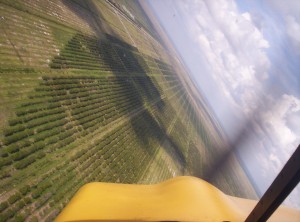Unstable Turn - Too Tippy and Uncomfortable
by Jim Alsip

With airplane established in a level turn, the sight picture clearly shows the nose move below the horizon. The pilot would typically react with elevator back pressure to hold the nose up. But wait! Is this a pilot induced deviation from a stable turn? Is it a possibility that the pilot is setting up for a loss of control incident?
Pilot school rarely mentions Sir Isaac Newton and his universal laws of motion. Those laws are not optional; they always apply and a pilot must adhere to them. Disrespect Newton and you will most certainly have a bad day; for example, Newton tells us that when we do stuff, other stuff happens.
Pilots know that a proper turn requires coordination of aileron and rudder input; but in truth many pilots never lean that skill set. Some pilots try to use rudder, and frequently develop the habit of holding in-turn rudder. Consider the situation in the photo. The pilot is established in a level turn. With reference to flight control inputs, consider the following:
- Rudder controls adverse yaw when rolling into and out of a turn. When established in a level turn, ailerons return to neutral so there is no adverse yaw and no need for rudder.
- If pilot continues in-turn rudder, the airplane will yaw, rotate on the vertical axis. Note the bank angle in photo and you can see that with a yawing moment (rotation to the left), the nose will appear to be falling (the nose is moving down).
- A typical pilot reaction is to apply elevator back pressure and get that nose up. Seems right, but Newton would disagree.
Newton's universal law of motion is very clear about this situation - the pilot applied inappropriate rudder input and when you do stuff, other stuff happens.
- In-turn rudder causes the nose to drop
- A falling nose increases airspeed and losses altitude.
- Pilot increases angle of attack with elevator, thereby stopping loss of altitude but also slowing airspeed (elevator controls airspeed).
- Reduced airspeed reduces lift and the plane will lose altitude and the nose will drop to recover airspeed.
- Pilot might typically see where this is going so the addition of power might be appropriate.
- Meanwhile, the use of in-turn rudder has caused the bank to increase. Rotation on the longitudinal or vertical axis will cause rotation on the other (that is called linkage).
- Pilot will apply out-turn aileron to control over-bank and thereby sets up a cross control situation and a lot of drag.
- The cross control drag slows airspeed, but the pilot knows to add power and or apply some more elevator input.
This ridiculous situation is an example of pilot induced oscillation and a very unstable turn. Typically the pilot is rescued from an unstable turn when he rolls out of the turn. Less often, the misuse of the flight controls will result in the dreaded stall/spin event. A little in-turn rudder is a common misuse of flight controls that results in unstable turns and causes pilot discomfort. Many pilots resolve this situation by avoiding steep bank angles during turns.
Key point: To avoid over control and pilot induced oscillation, understand that when you do stuff, other stuff happens. Do not wiggle the controls. Understand what the flight controls do and only use the control you need, when you need it and as much as needed.
To read more Hangar Talk articles, visit Dylan Aviation's website: https://www.dylanaviation.com/hangar-talk/

